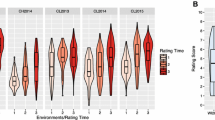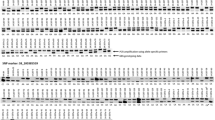Abstract
Selection for phomopsis stem blight disease (PSB) resistance is one of the key objectives in lupin (Lupinus angustifolius L.) breeding programs. A cross was made between cultivar Tanjil (resistant to PSB) and Unicrop (susceptible). The progeny was advanced into F8 recombinant inbred lines (RILs). The RIL population was phenotyped for PSB disease resistance. Twenty plants from the RIL population representing disease resistance and susceptibility was subjected to next-generation sequencing (NGS)-based restriction site-associated DNA sequencing on the NGS platform Solexa HiSeq2000, which generated 7,241 single nucleotide polymorphisms (SNPs). Thirty-three SNP markers showed the correlation between the marker genotypes and the PSB disease phenotype on the 20 representative plants, which were considered as candidate markers linked to a putative R gene for PSB resistance. Seven candidate markers were converted into sequence-specific PCR markers, which were designated as PhtjM1, PhtjM2, PhtjM3, PhtjM4, PhtjM5, PhtjM6 and PhtjM7. Linkage analysis of the disease phenotyping data and marker genotyping data on a F8 population containing 187 RILs confirmed that all the seven converted markers were associated with the putative R gene within the genetic distance of 2.1 CentiMorgan (cM). One of the PCR markers, PhtjM3, co-segregated with the R gene. The seven established PCR markers were tested in the 26 historical and current commercial cultivars released in Australia. The numbers of “false positives” (showing the resistance marker allele band but lack of the putative R gene) for each of the seven PCR markers ranged from nil to eight. Markers PhtjM4 and PhtjM7 are recommended in marker-assisted selection for PSB resistance in the Australian national lupin breeding program due to its wide applicability on breeding germplasm and close linkage to the putative R gene. The results demonstrated that application of NGS technology is a rapid and cost-effective approach in development of markers for molecular plant breeding.



Similar content being viewed by others
References
Baird NA, Etter PD, Atwood TS, Currey MC, Shiver AL, Lewis ZA, Selker EU, Cresko WA, Johnson EA (2008) Rapid SNP discovery and genetic mapping using sequenced RAD markers. PLoS ONE 3(10):e63376
Baxter SW, Davey JW, Johnston JS, Shelton AM, Heckel DG (2011) Linkage mapping and comparative genomics using next-generation RAD sequencing of a non-model organism. PLoS One 6(4):e19315
Boersma JG, Pollotta M, Li C, Buirchell BJ, Sivasithamparam K, Yang H (2005) Construction of a genetic linkage map using MFLP, and identification of molecular markers linked to domestication genes in narrow-leafed lupin (Lupinus angustifolius). Cell Mol Biol Lett 10:331–344
Boersma JG, Buirchell BJ, Sivasithamparam K, Yang H (2007) Development of a PCR marker tightly linked to mollis, the gene that controls seed dormancy in Lupinus angustifolius L. Plant Breed 126:612–616
Brugmans B, van der Hulst RGM, Visser RGF, Lindhout P, van Eck HJ (2003) A new and versatile method for the successful conversion of AFLP markers into simple single locus markers. Nucleic Acids Res 31:e55
Burr B, Burr FA, Thompson KH, Albertsen MC, Stuber CW (1988) Gene mapping with recombinant inbreds in maize. Genetics 118:519–526
Catchen JM, Amores A, Hohenlohe P, Cresko W, Postlethwait JH (2011) Stacks: building and genotyping loci de novo from short-read sequences. G3 Genes, Genomes, Genetics 1:171–182
Chutimanitsakun Y, Nipper RW, Cuesta-Marcos A, Cistue L, Corey A, Filichkina T, Johnson EA, Hayes PM (2011) Construction and application for QTL analysis of a restriction site associated DNA (RAD) linkage map in barley. BMC Genomics 12:4
Cowling WA, Hamblin J, Wood PM, Gladstones JS (1987) Resistance to Phomopsis stem blight in Lupinus angustifolius L. Crop Sci 27:648–652
Eagles HA, Bariana HS, Ogbonnaya FC, Rebetzke GJ, Hollamby GJ, Henry RJ, Henschke PH, Carter M (2001) Implementation of markers in Australian wheat breeding. Austr J Agric Res 52:1349–1356
Gladstones JS (1970) Lupins as crop plants. Field Crop Abstr 23:123–148
Gupta PK, Varshney RK, Sharma PC, Ramesh B (1999) Molecular markers and their applications in wheat breeding. Plant Breed 118:369–390
Holland JB (2004) Implementation of molecular markers for quantitative traits in breeding programs—challenges and opportunities. Proceedings of the 4th International Crop Science Congress, 26 Sep–1 Oct 2004. Brisbane, Australia (www.cropscience.org.au)
Lewis ZA, Shiver AL, Stiffler N, Miller MR, Johnson EA, Selker EU (2007) High-density detection of restriction-site associated DNA markers for rapid mapping of mutated loci in Neurospora. Genetics 177:1163–1171
Li X, Yan G, Renshaw D, Yang H (2010) Development of a co-dominant DNA marker tightly linked to gene tardus conferring reduced pod shattering in narrow-leafed lupin (Lupinus angustifolius L.). Euphytica 176:49–58
Li X, Yang H, Buirchell B, Yan G (2011) Development of a DNA marker tightly linked to low-alkaloid gene iucundus in narrow-leafed lupin (Lupinus angustifolius L.). Crop Pasture Sci 62:218–224
Li X, Buirchell B, Yan G, Yang H (2012) A molecular marker linked to the mollis gene conferring soft-seediness for marker-assisted selection applicable to a wide range of crosses in lupin (Lupinus angustifolius L.) breeding. Mol Breed 29:361–370
Lin R, Renshaw D, Luckett D, Clements J, Yan G, Adhikari K, Buirchell B, Sweetingham M, Yang H (2009) Development of a sequence-specific PCR marker linked to the gene “pauper” conferring low alkaloids in white lupin (Lupinus albus L.) for marker assisted selection. Mol Breed 23:153–161
Luby JJ, Shaw DV (2001) Does marker-assisted selection make dollars and sense in a fruit breeding program? HortScience 36:872–879
Manly KF, Cudmore RH Jr, Meer JM (2001) MapManager QTX, cross-platform software for genetic mapping. Mamm Genome 12:930–932
Michelmore RW, Paran I, Kesseli RV (1991) Identification of markers linked to disease-resistance genes by bulked segregant analysis: a rapid method to detect markers in specific genomic regions by using segregating populations. PNAS 88:9828–9832
Miller MR, Dunham JP, Amores A, Cresko WA, Johnson EA (2007) Rapid and cost-effective polymorphism identification and genotyping using restriction site associated DNA (RAD) markers. Genome Res 17:240–248
Nelson MN, Moolhuijzen PM, Boersma JG, Chudy M, Lesniewska K, Bellgard M, Oliver RP, Święcicki W, Wolko B, Cowling WA, Ellwood SR (2010) Aligning a new reference genetic map of Lupinus angustifolius L. with the genome sequence of the model legume, Lotus japonicus. DNA Res 17:73–83
Ogbonnaya FC, Subrahmanyam NC, Moullet O, de Majnik J, Eagles HA, Brown JS, Eastwood RF, Kollmorgen J, Appels R, Lagudah ES (2001) Diagnostic DNA markers for cereal cyst nematode resistance in bread wheat. Austr J Agric Res 52:1367–1374
Paran I, Michelmore RW (1993) Development of reliable PCR-based markers linked to downy mildew resistance genes in lettuce. Theor Appl Genet 85:985–993
Pfender WF, Saha MC, Johnson EA, Slabaugh MB (2011) Mapping with RAD (restriction-site associated DNA) markers to rapidly identify QTL for stem rust resistance in Lolium perenne. Theor Appl Genet 122:1467–1480
Sadeghzadeh B, Rengel Z, Li C, Yang H (2010) Molecular marker linked to a chromosome region regulating seed Zn accumulation in barley. Mol Breed 25:167–177
Shan X, Blake TK, Talbert LE (1999) Conversion of AFLP markers to sequence-specific PCR markers in barley and wheat. Theor Appl Genet 98:1072–1078
Shankar M, Cowling WA, Sweetingham MW (1996) The expression of resistance to latent stem infection by Diaporthe toxica in narrow leafed-lupin. Phytopathology 86:692–697
Shankar M, Sweetingham MW, Cowling WA (2002) Identification of alleles at two loci controlling resistance to Phomopsis stem blight in narrow-leafed lupin (Lupinus angustifolius L.). Euphytica 125:35–44
Sharp PJ, Johnston S, Brown G, McIntosh RA, Pallotta M, Carter M, Bariana HS, Khatkar S, Lagudah ES, Singh RP, Khairallah M, Potter R, Jones MGK (2001) Validation of molecular markers for wheat breeding. Austr J Agric Res 52:1357–1366
Snape JW (2004) Challenges of integrating conventional breeding and biotechnology: a personal view! Proceedings of the 4th International Crop Science Congress, 26 Sep–1 Oct 2004. Brisbane, Australia (www.cropscience.org.au)
Sunnucks P, Wilson ACC, Beheregaray LB, Zenger K, French J, Taylor AC (2000) SSCP is not so difficult: the application and utility of single-stranded conformation polymorphism in evolutionary biology and molecular ecology. Mol Ecol 9:1699–1710
Van Warmelo KT, Marasas WFO, Adelaar TF, Kellerman TS, Van Rensburg IBJ, Minne JA (1970) Experimental evidence that lupinosis of sheep is a mycotoxicosis caused by the fungus Phomopsis leptostromiformis (Kuhn) Bubak. J Afr Vet Med Assoc 41:235–247
Van OH, Stam P, Visser R, Van EH (2005) RECORD: a novel method for ordering loci on a genetic linkage map. Theor Appl Genet 112:30–40
Williamson PM, Sivasithamparam K, Cowling WA (1991) Formation of subcuticular coralloid hyphae by Phomopsis leptostromiformis upon latent infection of narrow-leafed lupin. Plant Dis 75:1023–1026
Wittenberg AH, van der Lee T, Cayla C, Kilian A, Visser RG, Schouten HJ (2005) Validation of the high-throughput maker technology DArT using the model plant Arabidopsis thaliana. Mol Gen Genomics 274:30–39
Yang H, Shankar M, Buirchell BJ, Sweetingham MW, Caminero C, Smith PMC (2002) Development of molecular markers using MFLP linked to a gene conferring resistance to Diaporthe toxica in narrow-leafed lupin (Lupinus angustifolius L.). Theor Appl Genet 105:265–270
Yang H, Boersma JG, You M, Buirchell BJ, Sweetingham MW (2004) Development and implementation of a sequence-specific PCR marker linked to a gene conferring resistance to anthracnose disease in narrow-leafed lupin (Lupinus angustifolius L.). Mol Breed 14:145–151
Yang H, Renshaw D, Thomas G, Buirchell B, Sweetingham M (2008) A strategy to develop molecular markers applicable to a wide range of crosses for marker assisted selection in plant breeding: a case study on anthracnose disease resistance in lupin (Lupinus angustifolius L.). Mol Breed 21:473–483
Acknowledgments
We thank Dr. Mingpei You for her assistance in phenotyping PSB disease resistance on plant materials used in this study.
Author information
Authors and Affiliations
Corresponding author
Additional information
Communicated by D. Lightfoot.
Electronic supplementary material
Below is the link to the electronic supplementary material.
Rights and permissions
About this article
Cite this article
Yang, H., Tao, Y., Zheng, Z. et al. Rapid development of molecular markers by next-generation sequencing linked to a gene conferring phomopsis stem blight disease resistance for marker-assisted selection in lupin (Lupinus angustifolius L.) breeding. Theor Appl Genet 126, 511–522 (2013). https://doi.org/10.1007/s00122-012-1997-1
Received:
Accepted:
Published:
Issue Date:
DOI: https://doi.org/10.1007/s00122-012-1997-1




